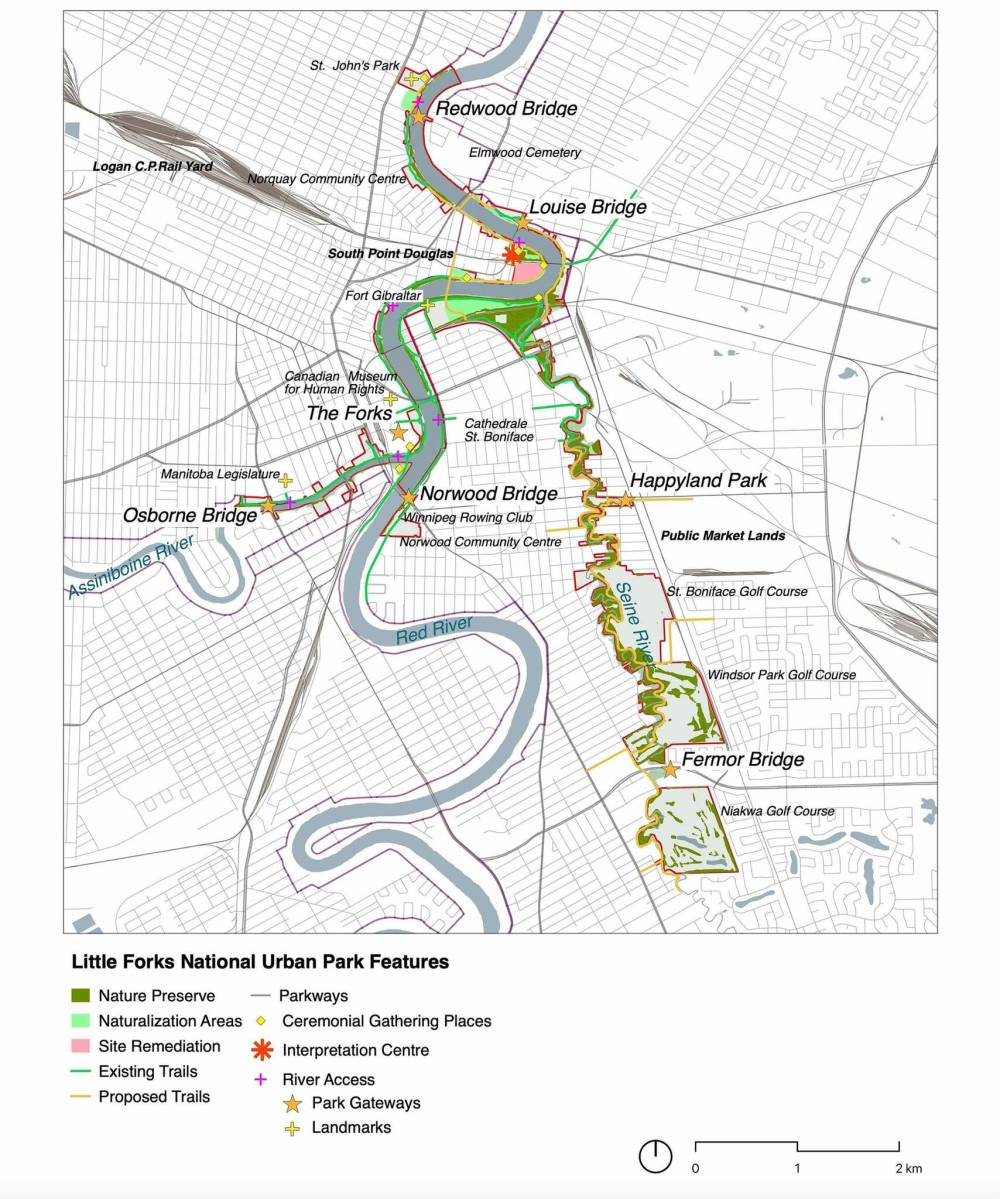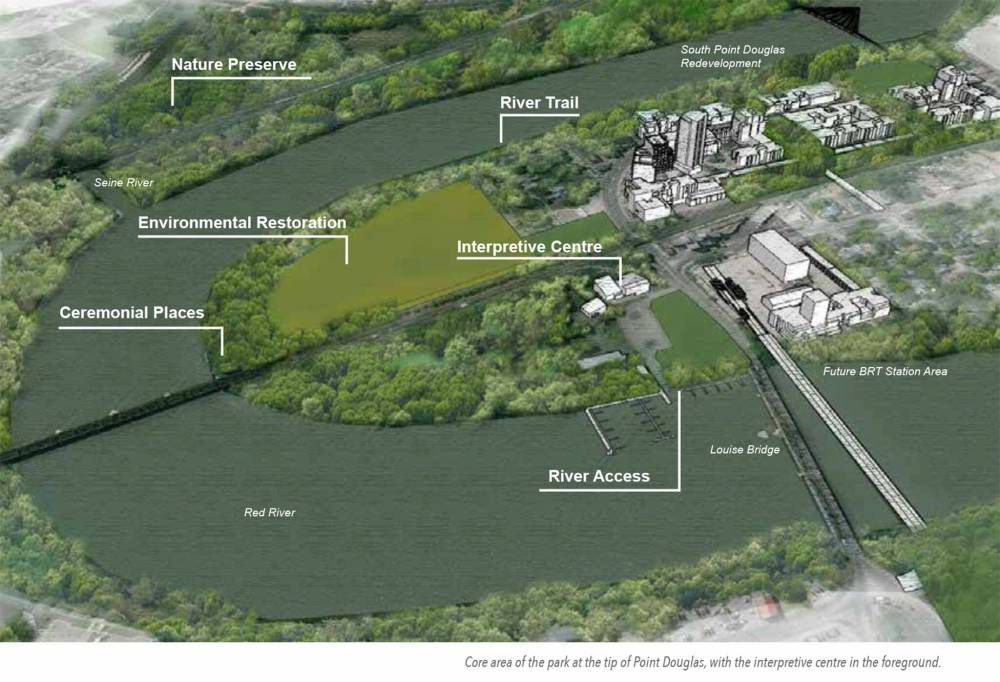There’s a tough road ahead, but proponents of an urban national park in Point Douglas, dubbed “Little Forks,” say it can be done.
“This is not going to be a slam dunk,” said former premier Gary Doer at an event to launch the proposal Wednesday.
The plan would preserve 430 hectares of land and water in the centre of the city and connect the Red, Seine and Assiniboine river corridors.

RUTH BONNEVILLE / FREE PRESS
Former premier Gary Doer said the project is not unprecedented and would be good for the city as whole.
It includes a nature preserve, interpretive centre, various boat launches and trails.
The goal is to restore more than 40 acres of former industrial land, plant 85,000 trees and protect 10 kilometres of waterways — from the Niakwa Golf Course near the Trans-Canada Highway, in the south, to the tip of St. John’s Park in the North End. The area is more than three times the size of Assiniboine Park.
The advisory committee struck to move the proposal forward says the roadblocks are worth the long-term benefits.
“Now is the time to protect Winnipeggers’ rivers in perpetuity,” said committee member Jean Trottier. “Look forward 50 years and imagine what the rest of the places around us, up and down the rivers, could look like with a little care and determination.”
Trottier, an associate professor of landscape architecture at the University of Manitoba, said the project would take decades, but the wait is worth the environmental rewards.
Doer said the project is not unprecedented and would be good for the city as whole.
“I remember The Forks discussions: everybody had an opinion, everybody said we were doing it wrong… It was criticized as being too expensive and we couldn’t afford it — but we don’t have that criticism anymore,” he said.
In 1987, the vision for The Forks was proposed, which involved buying land at the junction of the Red and Assiniboine rivers and converting the decommissioned rail yard into public space. It was estimated to cost $21 million, Doer said.
Today, the cost of “Little Forks” — the voyageurs’ name for the confluence of the Red and Seine rivers — is in the same ballpark.
However, it is a relatively clean slate: the Higgins Avenue parcel of land is mostly bare save for a boat launch, small parking lot and a few homeless encampments on the riverbanks.

SUPPLIED
The plan would preserve 430 hectares of land and water in the centre of the city and connect the Red, Seine and Assiniboine river corridors.
Various levels of government, landowners and Indigenous and community organizations will need to come together before the citizen-led initiative becomes a reality.
City Coun. Sherri Rollins attended the event and supports the project.
“I’ve long been a proponent of expanding our parks along waterways for the viability and health of our city. This is a big, city-opening decision and I hope people remember that.”
The idea of turning the area into a park has been considered since at least 2009, when residents floated the idea of converting the North Point Douglas space into a provincial park to Doer, who was premier at the time.
After the federal government promised $130 million to create a network of national urban parks in 2021, a planning group met to put together the current proposal.
In August of that year, Parks Canada announced it had signed statements of collaboration with Winnipeg, Halifax and Windsor, Ont., and was working to identify potential urban park sites in Montreal, Edmonton and Colwood, B.C.
Manitoba Métis Federation president David Chartrand is a member of the national committee tasked with picking the location for Winnipeg’s national urban park. He said committee members are “very close” to making a decision.
He said he personally favours the Point Douglas location over other proposals.
“It would be fitting to our downtown area,” he said Wednesday. “Everybody should have the right and opportunity to have a place to take their families and have a beautiful park nearby.”
A local health-care worker said he hopes the group considers people like him, who use city-owned parcels of land in Point Douglas for Indigenous ceremonies.

SUPPLIED
The idea of turning the area into a park has been considered since at least 2009.
Last year, Lee Sanderson erected a sweat lodge and ceremony space on the property with permission from Point Douglas Coun. Vivian Santos. The space gets about a dozen visits each week from homeless people and those struggling with mental health and addictions.
On a map of the proposed park, eight spots are marked for “ceremonial gathering spaces.”
Sanderson, who is a trauma worker for the Winnipeg Regional Health Authority, worries the sacred nature of ceremonies could be threatened by park-goers.
“What if it becomes harder to perform the ceremony… when there’s people walking around with cameras?” he said. “It’s more of a spectacle.”
Rollins said the advisory committee must collaborate with people who currently use the space.
“We have our work cut out for us to make sure we’re restoring the area and including the community in that conversation,” she said. “(The community) is not barriers, they’re embedded in the project.”
nicole.buffie@freepress.mb.ca

Nicole Buffie
Multimedia producer
Nicole Buffie is a multimedia producer who reports for the Free Press city desk. Born and bred in Winnipeg, Nicole graduated from Red River College’s Creative Communications program in 2020 and worked as a reporter throughout Manitoba before joining the Free Press newsroom in 2023. Read more about Nicole.
Every piece of reporting Nicole produces is reviewed by an editing team before it is posted online or published in print — part of the Free Press‘s tradition, since 1872, of producing reliable independent journalism. Read more about Free Press’s history and mandate, and learn how our newsroom operates.
Our newsroom depends on a growing audience of readers to power our journalism. If you are not a paid reader, please consider becoming a subscriber.
Our newsroom depends on its audience of readers to power our journalism. Thank you for your support.